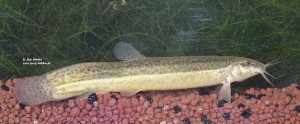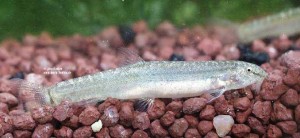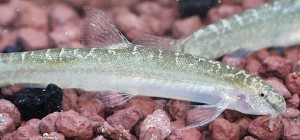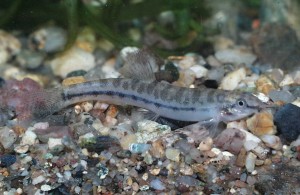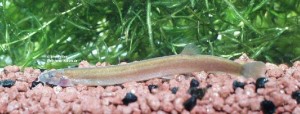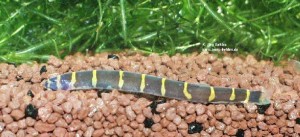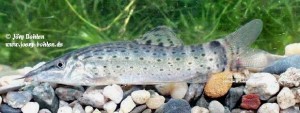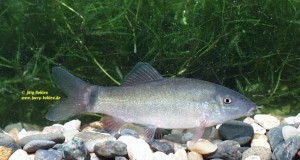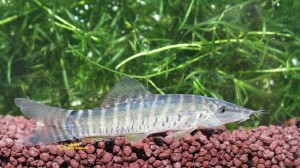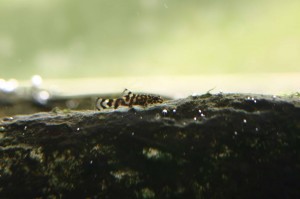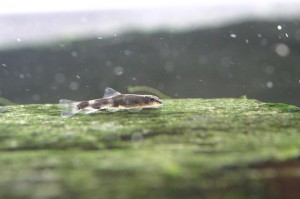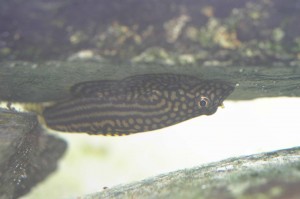Family COBITIDAE
Loach fishes of the genera Cobitis and Sabanejewia are my main focus, since they meet both my aquaristic as well as scientific interests. I have a live-fish collection in aquaria and spawn and breed as many of them as possible. The first picture shows the habitus of a Cobitis, the second a Sabanejewia. They are planned to get an own part or the page, but I have to find the time for that.
Here you may find my list of literature about Cobitis, Sabanejewia and related general
Here a male of Paramisgurnus dabryanus. These nice guys learn within days to eat food from your fingers and are as hardy as a fish can be. The pictured specimen was bought on a fishmarket in China, was carried for the whole day in a plastic bag through the shopping centres of the city, went in the evening to get some water in the sink of the hotel, stayed there for some days before he was pressed with 5 more specimens (all adult) into a PET flask and was carried in the airplane to Europe. But also when all other fishes in a tank were heavily loaded with ichthyophthyrius, they still smile and look good, or when water quality drops until the ‚grey stage‘, they do not show a sign of unpleasantness. Though they are!!
These pictures show Lepidocephalichthys irrorata (if properly identified) from aquarium trade. These tiny little fishes make me much pleasure, since they are well-going active fishes and also make me believe they would spawn in my tanks (on the left photo the female has just a very small belly, later you can see the eggs in through the body wall). This species surprised me much because the males (right photo) developed horizontal swellings of the body sides. The swellings are located in the dorsal half of the body sides behind dorsal fin base and slightly greenish in colour. So the swellings are exactly what males of Misgurnus have, although such swellings are unknown from any other species of Lepidocephalichthys. Besides the swelling, the male bears, like all males of Lepidocephalichthys, a thickened last pectoral fin ray. (May 2007)
Another male of Lepidocephalichthys from ornamental fish trade, also on this specimen you may see the thickened last pectoral fin ray. Unfortunately I have no idea about the species identification. (May 2007)
Some representatives of the genus Pangio from ornamental fish trade. Several species of Pangio are difficult to identify, especially the brown ones and the banded ones without nasal barbel. However, I guess that the left one is P. oblonga and the right one is P. myersi. All Pangio make nice aquarium inhabitants and can live long. There are even hobbyists which breed them without help of hormone injections (to the fish, not the hobbyist), but I did not manage this, yet. (May 2007)
Family BOTIIDAE
And now to something completely different – loaches! However, these fishes belong to the family Botiidae, a family that was erected by Theodor Nalbant in 2001 and proofed to be valid by genetic studies. Here are pictured the species Syncrossus beauforti, Yasuhikotakia eos and Syncrossus helodes. For those who wonder about the strange generic names: After the works of Nalbant in 2002 and Maurice Kottelat in 2004 there are 7 genera of Botiidae: Chromobotia (for the clown loach macracanthus only), Botia (for the species on the Indian subcontinent; e.g. striata, almorhae, kubotai), Leptobotia, Parabotia and Sinibotia (for the Chinese species), Yasuhikotakia (for species like modesta, eos, lecontei and others) and Syncrossus (containing berdmorei, beauforti, helodes, hymenophysa and reversa). A genetic study done by Šlechtová et al. in 2006 confirmed these genera and additionally showed that the species pair sidthimunki – nigrolineata do not fit properly to any genus. (May 2007)
Family BALITORIDAE
The family Balitoridae contains suckerbelly loaches and relatives.
One of the favourite species in ornamental fish trade is Sewellia lineolata from Vietnam. A beautiful fish for sunexposed aquaria with strong current and many stones. The first photo shows an adult hanging under a stone (no, the picture was not placed upside-down by mistake); the second shows a baby of 8 mm total length (21.5.2007). This is the size when they leave the shelter of the gravel they live in as early babies. At this size, they are not flat like the adults and do not have fins suited for sucking, but look a little bit like a nemacheilid loach. They also behave like nemacheilids, e.g. they are unable to attach to the surface, but lay and swim on the top of horizontal areas. A very similar shape can be observed in very small juveniles of Vanmannenia, another genus of Balitoridae (shown on third picture).
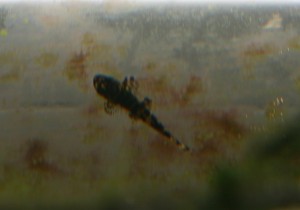
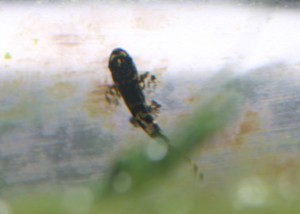
Some new pictures of the little Sewellia lineolata. They are now (5.6.2007) 13 mm total length and today I observed the first specimens to attach to the glass. Their body shape still is somehow nemacheilid-like and the fins are by far not the size of those of the adults, but they manage to suck with them. The fish was mainly hanging on some parts of the glass with a layer of algae and was eating from them. Therefore the behaviour was already very much like that of an adult.
Some aquaristic notes on loaches were published in the following articles:
- Bohlen, J. 2004: Steinbeisser aus China im Handel. Aquaristik Fachmagazin (in press)
- Bohlen, J. 2004: Zwei kleine Schmerlen aus der Gattung Lepidocephalichthys. Aquaristik Fachmagazin (in press)
- Bohlen, J. 2004: Vielfalt und aquaristische Pflege von Goldsteinbeissern, Sabanejewia. Aquaristik Fachmagazin 175: 36-39.
- Bohlen, J. 2002: Verhaltenselemente von Steinbeissern der Gattungen Cobitis und Sabanejewia im Aquarium. in: Riehl, R. & H. Greven (Eds.): Verhalten der Aquarienfische (2), Schmettkamp-Verlag, Bornheim: 9-16
- Breil, M. & J. Bohlen 2003: Der anatolische Riesensteinbeisser, Cobitis bilseli. DATZ 7/2003: 37-39.
- Bohlen, J. 2002: Verhaltenselemente von Steinbeissern der Gattungen Cobitis und Sabanejewia im Aquarium. in: Riehl, R. & H. Greven (Eds.): Verhalten der Aquarienfische (2), Schmettkamp-Verlag, Bornheim: 9-16 http://wellsexstories.com/lesbian/.
- Breil, M. & J. Bohlen 2002: Turcinoemacheilus kosswigi – eine ungewöhnliche Schmerle aus dem Euphrat-Tigris-System. Aquaristik Fachmagazin 167: 56-58.


